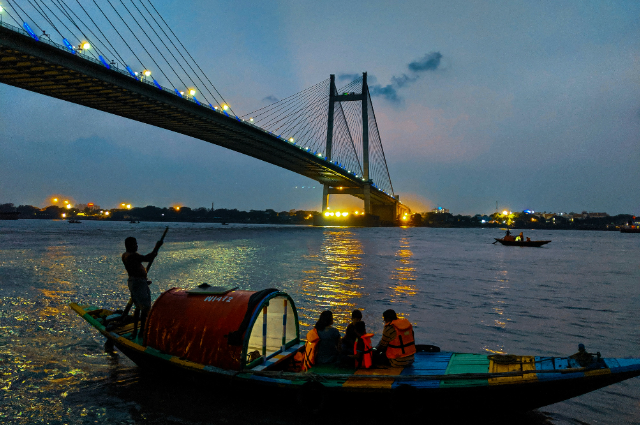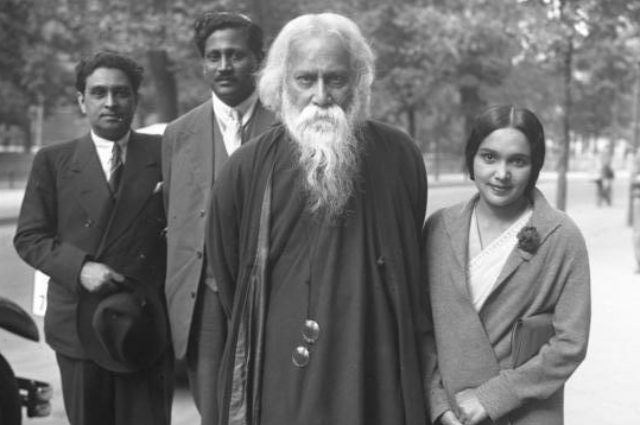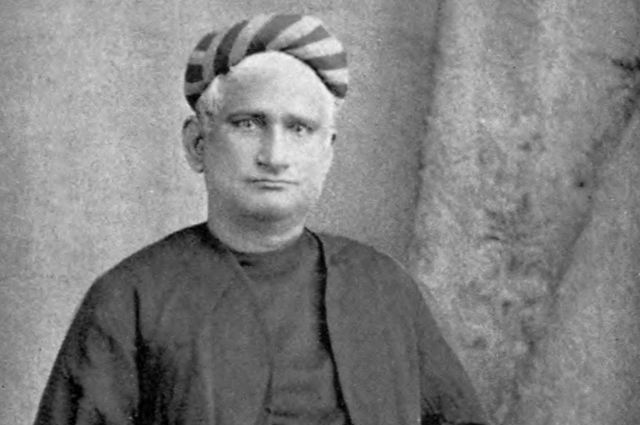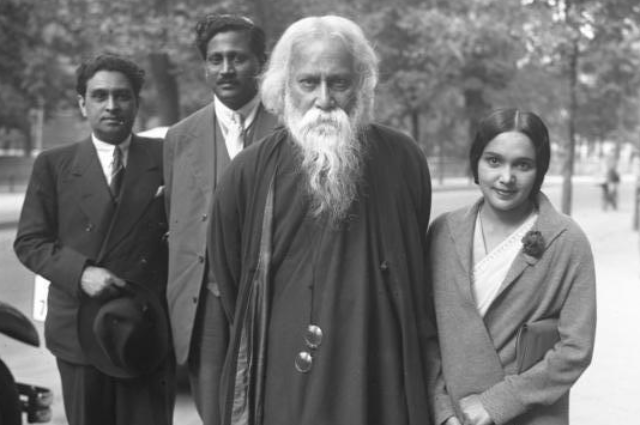
Photo by ABHISHEK CHAKRABORTY on Unsplash
In the context of cultural heritage and history of West Bengal, since the 18th century Bengalis have been cultivating both Bengali and English literature. The 1913 Nobel Prize in literature was awarded to Bengali polymath Rabindranath Tagore. His literature influenced both Indian and Bengali literature. In 1906 Satyendra Nath Tagore founded India's first educational organization, NCE National Council of Education-Bengal (Kolkata) to promote science and technology. 12 people of India won the Nobel Prize, 4 of them from West Bengal, Rabindranath Tagore, Amartya Sen, Muhammad Yunus and Abhijeet Banerjee. In the 19th century West Bengals education was much better than now. Its culture is very numerous as it mingles with the colors of Holi and Diwali, Durga Puja and Chhau Dance of Hindus and Eid, Bakra-Eid, and Eid Milad Un Nabi of Muslims. Moreover, in this work archaeological, historical and anthropological research of domestic and qualitative data from the interviews, abroad Islamic saints, Books, Magazines, Articles and Group Discussions as well. This Article aims to display the Cultures as Fine arts, Food, Traditional Dress, Music, Festivals, Dance and the contribution of Bengalis to Indian literature as the father of Bengali literature Ishwar Chandra Bandyopadhyay (Vidyasagar), Rabindranath Tagore's contribution to English literature and father of Bengali essay Bankim Chandra Chattyapadhyay and Megasthenes played the vital role in the study of Indian history. He is well documented as the father of Indian history for his remarkable accounts of ancient India. Bengali folklore includes poetry, drama, folktales and ballads etc. Rabindranath received the folklore in west Bengal and played the revival movement for that. Why is this all for? These all are to balance the current situation of Indian literature and linguistic fettle. Mostly government support to revitalize Indian literature, empower teachers and educators, digital literacy system and promote cultural revival are mandatory.
The Cultures of Bengal
It reflects the rich cultural heritage of the Bengali people, spread across Bangladesh and the Indian states of West Bengal and Tripura. With a history of over 1,400 years, Bengal’s culture has evolved through a blend of indigenous traditions and external influences. The region has produced significant contributions to Indian classical music, visual arts, literature, and folk traditions. Music: Bengal has produced renowned musicians such as Ravi Shankar and Ali Akbar Khan. Its folk traditions include the Baul mystics, with Lalon Shah being a prominent figure. Literature: Rabindranath Tagore, the first non-European Nobel laureate, and Kazi Nazrul Islam are two towering literary figures who shaped modern Bengali literature. Art and Dance: Bengali art includes ancient scroll and Kalighat paintings, and its dance forms range from classical to folk traditions. Cuisine: The food of Bengal is famous for its rice dishes, fish preparations, sweets like Rasgulla, and fermented fish. Festivals and Religion: Major festivals like Durga Puja, Pahala Baisakhi, Eid, and Christmas are celebrated, representing the religious diversity of the region. Textiles: The Jamdani muslin and silk from Bengal were historically famous exports. Sports: Cricket and football dominate, but traditional games like lathi khela and boat racing are still celebrated. Bengal’s unique cultural fabric binds its people through shared customs, arts, and traditions.
Discovering the Diverse Culture of West Bengal: A glimpse on its heritage
West Bengal, a state famous for its rich cultural heritage, is an incredible fusion of tradition and contemporary times. With its rich past and its bustling present, this state is a cultural paradise with a diverse mix of influences that have contributed to its identity. Its literature, art, music, festivals, and cuisine all bear testimony to the rich fabric of Bengal's culture, which makes it one of the culturally richest states of India.
A Legacy of Literature
West Bengal's contribution to literature is deep and extensive. Legendary authors like Rabindranath Tagore, Sharat Chandra Chattopadhyay, Bankim Chandra Chattopadhyay, and Kazi Nazrul Islam have left an unerasable imprint on Bengali and world literature. Tagore's poetic genius was rewarded with the Nobel Prize for Literature in 1913, and his impact is felt worldwide. Along with these legends, folk tales like the Thakurmar Jhuli and Gopal Bhar stories occupy a place of immense love in Bengali hearts. The development of Bengali literature went on through movements like Kallol and Hungry, with poets like Jibanananda Das and Sunil Gangopadhyay becoming voices of modernity.
Art, Architecture, Theatre, Music and Dance
Bengal's art life is as heterogeneous as its citizens. The Bengal School of Art, spearheaded by visionaries like Abanindranath Tagore, transformed Indian painting by incorporating native aesthetics, freeing themselves from European influences. Bengal's fine arts persist, with street graffiti today presenting political statements, thus becoming a platform for social commentary. Architecture in West Bengal is a fascinating blend of historic influences. Kolkata, the former capital of British India, displays imposing buildings testifying to Indo-Saracenic, British, and Islamic architectural styles, so much so that it has become known as "City of Palaces." The combination of colonial-era buildings with temples, mosques, and rajbaris lends the cityscape a timelessness of beauty.
West Bengal's theater and cinema culture are as legendary as its literary tradition. The state has a rich cultural heritage of Jatra, a folk drama with music, dance, and theatre, often depicting religious tales, particularly those of Lord Krishna. The splendor of this art is only matched by the genius of Bengali cinema. With visionaries such as Satyajit Ray, who won international recognition, including an Academy Award, the state's film industry, lovingly referred to as Tollywood, continues to shape the global cinematic landscape. Filmmakers such as Rituparno Ghosh, Aparna Sen, and Nandita Roy keep the tradition alive, bringing out the depth and richness of human emotions through their work.
Music and dance are an inseparable part of the cultural tapestry of West Bengal. Soulful Baul songs, presented by traveling minstrels, bring forth the deepest feelings of love and faith. Other old forms like Gombhira, Bhawaiya, and Kirtan continue to add texture to the state's musical experience. Indian classical music and its influence, combined with Rabindra Sangeet—songs composed and written by Tagore—run deep in the state. The dance forms such as Chhau are equally enchanting, with participants wearing colorful masks and costumes and presenting spellbinding performances.
Cuisine and Traditional Dressing
Bengali cuisine is a visual and taste delight. Rice, the staple food, is accompanied by a host of curries, vegetables, fish, and meat. Fish is a focal point in Bengali cuisine, with delights such as Ilish mach (hilsa fish) and malai curry being the stars. Sweets are the other culinary signature, with Rasgulla, Sandesh, and Rasmalai being the sweet treats of choice. Traditional cuisine is supreme, but the contemporary Bengali indulges in a blend of Anglo-Indian, Chinese, Lebanese, and Thai food, infusing global cuisine into their rich culinary tradition. Bengali traditional clothing reflects the region’s rich cultural ethos. Women typically wear the classic sari, draped in a distinctive style, while men often don Dhoti-kurta during festive occasions. Over time, Western influences have brought about changes, and today, both men and women embrace a variety of clothing, including jeans, dresses, and skirts, particularly in urban centers like Kolkata. West Bengal's culture is a dynamic blend of past and present, of tradition and modernity. From its literature to its festivals, from its art to its cuisine, every element of Bengal's culture is filled with creativity, passion, and resilience. A visit to this culturally rich state is an opportunity to witness the depth and diversity of a people whose traditions continue to thrive, evolve, and inspire.
Folklore and Folk literature
Folklore is also known as folk-literature or oral tradition. Folk literature is about individual experience from a particular society. Folk have a wide range of understanding and connotations. The outpourings from the heart of native or traditional people takes the form of folklore. All folklore are oral traditions, the lore, traditional knowledge and belief of cultures often having no written language and they are transmitted by the words of mouth. Folklores contain the lofty thoughts of yore and highest metaphysical truths, normally comprehensible to laymen in a subtle, story form. It also can highlight the relevance of the stories of the past to the present generation, something which cannot strongly do. Literature in written form helps to preserve folktales and oral traditions, but in this world would have lost almost all folk and oral traditions. Indian literature, compared to any other literature of the world, played a dominant role in the preservation and propagation of oral traditions and folklore. Very ancients of this land, India, were past matters of all art forms that are folk. Sama Veda to name one, is probably the oldest form of folk music that has survived till date.
Literature and Folklore
The term "folk" encompasses ideas like "natural," "traditional," and "rural," and folklore refers to the oral traditions of these communities, passed down through stories, rituals, and beliefs. Unlike literature, which is written and preserves these stories, folklore is primarily oral, often encompassing myths, dramas, and rituals. Folk traditions convey deep cultural values, societal customs, and even metaphysical truths in accessible forms. In India, literature has played a critical role in preserving folklore, from ancient texts like the Sama Veda to more modern folk plays and songs. Women, in particular, have been instrumental in maintaining these traditions. Indian literature has helped bind diverse cultures, maintaining unity amidst regional differences, and has continued to be a vital force even in modern times with the efforts of organizations like Sahitya Academy. This institution supports the promotion of folk literature in multiple languages, ensuring the preservation of India's rich cultural heritage.
Bengal’s immense contribution to Indian literature
Bengalis Contribution to literature spanning from the Bengal Renaissance to modern times. It highlights the pivotal role of literary giants such as Rabindranath Tagore, Bankim Chandra Chattopadhyay, and Sarat Chandra Chattopadhyay, whose works like Gitanjali, Ananda Math, and Devdas deeply influenced both literature and social reform. The evolution of the Bengali language, enriched by diverse linguistic influences, forms a vital part of this legacy. Folk literature, including Baul songs and Bhatiali ballads, also holds an important place. Bengal’s socio-political climate inspired literary works that mirrored societal changes, while Rabindranath Tagore became a global icon through his poetry, especially Gitanjali. Bengali poetry and novels are celebrated for their emotional depth, with authors like Kazi Nazrul Islam, Jiban Ananda Das, and modern writers such as Sunil Gangopadhyay adding diverse perspectives. Bengal’s literary contributions extend beyond fiction into spirituality, with figures like Ramakrishna Paramahamsa and Swami Vivekananda shaping Indian philosophy.
Women authors, notably Mahasweta Devi and Nabaneeta Dev Sen, played a significant role in feminist literature. The article also discusses Bengali drama, children’s literature, and the influence of folklore. Translations have brought Bengal’s literary treasures to a global audience, and Bengali literature has greatly influenced cinema. Literary festivals and archives further preserve and celebrate this rich heritage.
Bankim Chandra Chattopadhyay to Indian Literature
Bankim Chandra Chattopadhyay (1838-1894) was a renowned Bengali poet, novelist, essayist, and journalist. He is most famous for his song "Vande Matram," which inspired Indian freedom fighters and became India's national song. Born in a traditional Bengali family, Bankim was one of the first two graduates of the University of Calcutta and later earned a law degree. He worked as a government official for 20 years, often clashing with British authorities. As a writer, Bankim is considered the "father of the modern novel in India," writing over 17 novels, historical romances, and essays. His first Bengali novel, Kapalkundala (1866), established his literary career. Other notable works include Ananda Math, Devi Chaudhurani, and Sitaram, many of which promoted Hindu nationalism. His song "Vande Matram" was included in Ananda Math and set to music by Rabindranath Tagore.
Bankim was also a religious reformer, advocating for internal reform of Hinduism to revive Bengal’s cultural pride. His works combined intellectual stimulation and moral revival. Through his writing, he aimed to inspire self-confidence in Bengalis and pride in their history and religion. Bankim’s literary and cultural contributions, especially in novels and religious commentary, significantly impacted Indian society and inspired future generations, both in literature and in the freedom struggle.
Rabindranath Tagore's contribution to Indian Literature
Rabindranath Tagore was a Bengali Polymath who reshaped Bengali literature and music as well as Indian art with contextual Modernism In the late 19th and early 20th centuries. Author of Gitanjali and its profoundly sensitive, fresh and beautiful verse, he became the first non-European to win the Nobel Prize in literature in 1913. Rabindranath Tagore, one of the most renowned writers of modern India, had a prolific career spanning over six decades. He produced a vast body of work in Bengali and English, including poems, songs, plays, novels, essays, and travelogues. Tagore is celebrated for his Nobel Prize in Literature in 1913, making him the first and only Indian to receive this honor, which symbolized India's cultural recognition on the global stage.
Despite his literary stature, Tagore often stayed distant from political movements like Gandhi's freedom struggle, famously criticizing nationalism in his 1917 lectures. This detachment reinforced his image as a spiritual visionary, especially in the West, where he was seen as a prophet of universal love and harmony, a continuation of the spiritual legacy of Vivekananda. His institution, Santiniketan, embodied his spiritual ideals and gained reverence as an ashram or sacred retreat. While much of his work, like Gitanjali, reflects spiritual themes, Tagore also wrote extensively on other topics, including fiction, politics, and travel, showing the diverse nature of his literary contributions. His influence, therefore, goes beyond spirituality and touches various facets of modern thought and culture.
Rabindranath Tagore's contribution to Indian poetry
Rabindranath Tagore is immense and multifaceted. His poetic journey can be divided into phases, each marked by unique thematic and stylistic developments. Early in his career, he was inspired by Bengali Vaishnava lyricists and the great classical poet Kalidasa. Tagore's first significant work, Sandhya-Sangeet (1882), marked the beginning of his poetic voice, filled with gloom and longing, representing a transitional phase. This was followed by Prabhat-Sangeet (1883), where Tagore moved from despair to hope, exploring themes of love, light, and spiritual awakening. With Manasi (1890), Tagore stepped into maturity, presenting a complex interplay of romantic imagination and inner conflict. Sonar Tori (1894) took this to another level, blending delicate imagery and deep emotional reflection. Chitra (1896) brought in aesthetic and religious undertones, especially with the poem Urvashi, which is regarded as a masterpiece in Bengali literature.
In his second phase, Tagore's works like Chaitali (1896) and Khal Para (1900) captured reflections of rural life and personal moods, while Katha O Kahini (1900) delved into Indian myths and legends, bringing stories of heroism and sacrifice to life. Tagore's poetic legacy is marked by his ability to combine elements of nature, love, spirituality, and humanity, often weaving in themes from Indian philosophy, folklore, and classical literature, while keeping a universal appeal. His works remain a profound influence on Indian poetry and literary traditions.
Contribution of Indian Women to English Literature
Indian women writers have significantly transformed Indian literature, particularly in the 20th century, through their unique perspectives and themes. Their works have become a powerful medium for modernism and feminist discourse, addressing both contemporary issues and longstanding societal challenges. Historically, women's contributions were often undervalued, overshadowed by patriarchal norms that prioritized male narratives. Many women writers emerged from affluent, educated backgrounds, leading to a focus on themes relevant to higher social strata, sometimes disconnected from the broader realities of Indian life. However, over the last four decades, the portrayal of women in literature has evolved from traditional depictions of self-sacrifice to more complex characters exploring identity and personal conflicts. Contemporary writers like Anita Desai,Arundhati Roy and Ashapurna Devi have expanded the literary landscape, tackling themes of marital bliss, cultural displacement, and assertive femininity. Their works reflect a renaissance in Indian literature, shaped by both Indian and Western feminist movements, and resonate with the aspirations of modern Indian women. The rise of self-help literature in India, marked by authors like Deepak Chopra, showcases the growing interest in Indian narratives. This shift indicates a broader acceptance and engagement with Indian writing in English, suggesting a vibrant future for the genre as it continues to evolve and flourish on the global stage.
Modern Bengal's Cultural and Literary Contributions
Contemporary Bengal, which includes West Bengal in India and Bangladesh, is a paradigm of cultural diversity and intellectual ferment. This vibrant land has never ceased to fascinate the world with its deep influence on literature, art, music, and ideas. From the revolutionary Bengal Renaissance to the world-acclaimed Bengali cinema, the cultural heritage of this country continues to flourish.
The Bengal Renaissance and Its Consequences
The 19th and early 20th centuries saw Bengal at the heart of the Bengal Renaissance, a transformative era of intellectual awakening and social reform. Spearheaded by visionaries like Raja Ram Mohan Roy, Ishwar Chandra Vidyasagar, and Swami Vivekananda, this movement questioned orthodox traditions and championed progressive ideals. Roy’s advocacy against sati and his promotion of women’s education laid the groundwork for societal change. Vivekananda, with his message of universal spirituality, inspired a global audience. Rabindranath Tagore, a giant of this period, revolutionized world literature. His writings, steeped in humanism and spirituality, were above cultural barriers. In 1913, Tagore was the first non-European to be awarded the Nobel Prize in Literature for his book Gitanjali. His evergreen poetry, novels, and plays still echo, highlighting the oneness of humanity.
Literary Landscapes: Poetry, Prose, and Drama
Contemporary Bengali literature is a repository of imagination, covering an unparalleled diversity of themes and forms. Poetry: Aside from Tagore, the poetic genius of Kazi Nazrul Islam, Jibanananda Das, and Sukumar Ray illuminate the literary horizon. Nazrul, being the "Bidrohi Kobi" (Rebel Poet), infused his poems with passionate fire and cries for justice. Jibanananda Das, who is sometimes considered a father of modernism in Bengali poetry, described the beauty and the sadness of Bengal with sorrowful eloquence. Sukumar Ray, with his playful and humorous children's poems, filled Bengali homes with laughter and fantasy.
Prose: It was the visionaries such as Sarat Chandra Chattopadhyay and Bankim Chandra Chatterjee who spearheaded the development of Bengali novels. Chattopadhyay's novels, such as Devdas and Parineeta, delved into the complexities of love and societal pressure, finding a universal resonance. Chatterjee's Anandamath, meanwhile, as a novel set during the Sannyasi Rebellion, proved to be a foundation stone of nationalist writing. Drama: Bengali theatre flourished under the pens of playwrights such as Girish Chandra Ghosh and Dwijendralal Ray. Their plays, usually drawn from mythology and history, dealt with urgent social concerns, producing a rich theatrical heritage that continues to inspire.
Artistic Expressions: Painting, Sculpture, and Music
Visual Arts: The Bengal School of Art, headed by Abanindranath Tagore and Nandalal Bose, brought in a renaissance in Indian painting. Fusing indigenous conventions and Western methods, their paintings had a romantic flair and glorified India's heritage. Their imagery of mythological and historical subjects continues to remain iconic. Sculpture: Ramkinkar Baij redefined Indian modern sculpture with his dynamic and expressive works. Influenced by folk traditions, Baij honored human strength and rural existence through his innovative, bold forms.
Philosophy and Science: Sri Aurobindo, a philosopher and mystic, formulated Integral Yoga, a spiritual path for human transformation. His writings discuss the synthesis of Western and Eastern philosophies, providing deep insights into spirituality and evolution. Jagadish Chandra Bose, a pioneering scientist, made groundbreaking contributions to plant physiology and radio wave technology. His path-breaking research bridged the divide between science and nature, paving the way for biophysics and more. Socio-Political Thought: Reformists such as Raja Ram Mohan Roy and Subhas Chandra Bose immensely contributed to India's socio-political fabric. The unrelenting fight by Roy for social justice and education ended practices of antiquity. The foresight, courage, and uncompromising commitment of Bose towards India's independence remain exemplary.
Cinema: A New Wave
Bengali cinema has left an irreversible imprint on the world stage. Satyajit Ray, the great filmmaker, brought to life the spirit of Bengal with masterpieces such as the Apu Trilogy, which sensitively captured rural existence and human nature. Filmmakers such as Ritwik Ghatak and Mrinal Sen delved into themes of social realism, political turmoil, and existential crises, enriching the tradition of cinema. Almost all Bengali films are based on the current situation of our society, state and nation and these are also based on education, politics and emotions etc. Now Tollywood movies have well developed edits, graphics, background musics, actions and the story of the films is in the next level. Some film’s named Cengiz have both languages Bangla and Hindi, Rong Baaz, Amazon Er Obhijan etc.
Result
Bengali Literature's Influence:
Bengali literature has been pivotal in shaping Indian literary traditions. Key figures such as Rabindranath Tagore, Bankim Chandra Chattopadhyay, and Sarat Chandra Chattopadhyay made significant contributions that influenced both literature and social reform in India. The Bengal Renaissance, marked by these literary giants, played a crucial role in the intellectual and cultural revival of India, blending modernity with traditional values. Rabindranath Tagore’s Contributions: Literary Achievements: Tagore’s prolific body of work includes poetry, novels, plays, and essays, making him a central figure in modern Indian literature. His renowned collection, Gitanjali, earned him the Nobel Prize in Literature in 1913, highlighting his global impact. Poetic Evolution: Tagore’s poetry evolved through various phases, from the melancholic Sandhya-Sangeet to the spiritually uplifting Gitanjali. His work combines romantic imagination with deep spiritual and philosophical themes, reflecting both personal introspection and universal truths.
Cultural and Educational Impact:
Tagore’s institution, Santiniketan, embodied his educational and spiritual ideals, becoming a revered centre of learning and cultural exchange. His emphasis on a holistic and inclusive approach to education and art left a lasting legacy. Comparative Analysis: Tagore’s works are compared with other Bengali and Indian literary figures to assess their thematic and stylistic influences. His ability to integrate elements of nature, spirituality, and humanity set a benchmark in Bengali literature, influencing subsequent generations of writers. Preservation and Legacy: Bengali literature, through figures like Tagore, has played a crucial role in preserving and promoting cultural heritage. The translation of Bengali literary works has brought them to a global audience, ensuring that their impact transcends regional and linguistic boundaries.
Conclusion:
In a nutshell, West Bengal with its rich and diverse culture, it charms as an Aldebaran. This land is mingled in the colour of the Holy and scented by the perfumes of Eid Al Fitr. Some noteworthy traditional cultures such as Chau dance, Rabindra Sangeet, Sari, Dhoti, Kurta, Panjabi and Pajama etc. Overall Bengal is blended by diverse festivals also, Eid, Puja and Christmas etc. Bengal is not well known for its culture only but also for Bengalis achievement and contribution in the field of Education as the first non european Nobel prize winner is, Rabindranath Tagore in literature, from Bengal. It has a rich contribution to Indian literature. The contributions of Bengal to literature, particularly through Tagore’s work, have significantly enriched the Indian literary landscape. His innovative approach and thematic depth continue to inspire and influence both national and international literary traditions. Not only Tagore also Bankim Chandra Chattyapadhyay and Ishwar Chandra Vidyasagar have played their key role in Indian literature. Also, women have participated in this phase as Mahasweta Devi and Nabaneeta Dev Sen, played a significant role in feminist literature. In a nutshell it has been proved that, how Bengal’s heritage is beautiful as the Bengalis contribution to Indian Literature is also, much beautiful.
. . .
Reference:
- https://www.holidify.com
- https://westbengal.pscnotes.com
- https://en.banglapedia.org/index.php/Folk_Literature
- https://cmsadmin.amritmahotsav.nic.in
- https://iaeme.com/MasterAdmin
- https://www.ijhssi.org/papers
- https://www.scribd.com/document/529879829/tagore
Disclaimer: This study employs a qualitative research approach, focusing on textual analysis and historical context. Primary sources include Rabindranath Tagore’s literary works and contemporaneous writings. Secondary sources encompass academic articles, books, and critical essays on Bengali literature. Data collection involves a comprehensive review of these sources to assess Tagore’s influence and contributions to Indian literature. The analysis includes thematic exploration and comparative study of Tagore’s works with other Bengali and Indian literary figures. Findings are synthesized to highlight the impact and legacy of Bengali literature in the broader Indian literary landscape.




